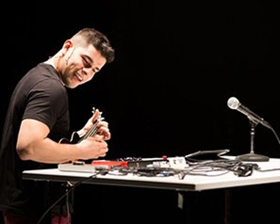Review: Brian Quijada Remixes the One-Man Show in WHERE DID WE SIT ON THE BUS? at City Theatre

As I braved the cold snap to attend Brian Quijada's one-man show Where Did We Sit on the Bus? at City Theater, across town a different hip-hop musical about Hispanic identity in America had taken the stage. Brian Quijada might not be a household name like Lin-Manuel Miranda, but there's something immensely appealing and scrappy in the DIY multimedia presentation Quijada and director Chay Yew have staged in the Southside (plus none of the sociopolitical drama about who does and does not get to play characters of Hispanic/Latinx background that recently plagued PMT's In the Heights. As either a white guy of Hispanic descent or a Hispanic guy of white descent, I'm gonna respectfully nope/no-me-diga out of THAT can of worms).
Brian Quijada's musical autobiography is quintessential City Theatre stuff, in that it doesn't fit easily in any of the major boxes as one-man show, stand-up comedy, musical, drama, spoken word piece, avant-garde cabaret or Ted talk. In a sense, it's all of the above combined, as Quijada tells a series of stories (beginning, Tristam Shandy-like, with his conception, gestation and birth) about his development as a human being, a performer, a "brown person" and a family man. As these stories go on and intertwine, the personal becomes political, and Quijada passionately speaks out against the idea that "black people" and "white people" are the dominant sociopolitical viewpoints in America, leaving the Hispanic experience as a footnote or political dog-whistle- an experience explored in greater depth when a school-age Quijada becomes close friends with a group of Jewish students. As another ethnic group seen as "outside the paradigm," this partnership seems logical in terms of Quijada's central theme, but he then explores the accusations of "whitebread" he received for palling around with this other non-brown social grup.
But enough about plot. Enough about text. Let's talk about music, because this show has a gimmick- and "gimmick" is not a pejorative- that must be seen to be believed. Brian Quijada is a raconteur, an actor, singer, dancer, comedian and rapper... but he's also a looper. The score to this particular musical is not performed by a pit band or pre-recorded; instead, it's performed live and Quijada layers every element himself, piece by piece over the course of the song, with the help of iPad app Loopy HD and a remote controller app on his iPod Touch. Beatboxing into a microphone, humming bass lines, singing his own backup vocals and adding texture with harmonica or electric ukulele, Quijada constructs the songs piece by piece, fitting them together so deftly that we forget we're watching the mixing process entirely. (A musical highlight: Quijada's sequence depicting the dance parties he attended in his community as a child, with a Latin dance beat suddenly turning into "Billie Jean" simply by removal of a few layers that were disguising the familiar pop tune.)
The silly and the serious live side by side in this show- Quijada can talk about his childhood idolizing the King of Pop one minute, complete with exaggerated dance mimicry, then flip the script to discuss how his father, an illegal immigrant, wanted nothing more than for his son to apply himself to a practical career and forge the kind of stable life his father had risked his life to build for his son. But the mood never feels like whiplash: rather, it's all parts of the same story, and the sour and sweet must be tasted together. By the time the tone shifts at the end of the show to a direct political address, I looked around the audience and saw almost no dissent or discomfort among the mostly older, mostly white audience- maybe they were all of one accord, or maybe being confronted by a living, breathing embodiment of a distant political debate made it harder to see things as purely impersonal.
Where Did We Sit on the Bus? is not Hamilton. It's not a genre-changing, titanic work of art. But it doesn't have to be- it's small, and personal, and do it yourself. I can't help but think that we are intended to walk away from the show thinking "I could do that: I could tell stories, I could make music with entry-level software, I could express myself." Not quite like Quijada does, but close.
Reader Reviews
Videos

